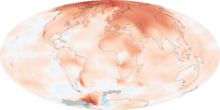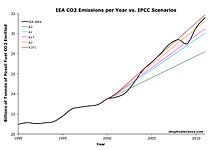This article is about the change in climate Earth is currently experiencing. For general discussion of how Earth's climate can change, see Climate change.
Global mean land-ocean temperature change from 1880–2010, relative to the 1951–1980 mean. The black line is the annual mean and the red line is the 5-year running mean. The green bars show uncertainty estimates. Source: NASA GISS
The map shows the 10-year average (2000–2009) global mean temperature anomaly relative to the 1951–1980 mean. The largest temperature increases are in the Arctic and the Antarctic Peninsula. Source: NASA Earth Observatory[1]
Fossil fuel related CO2 emissions compared to five of IPCC's emissions scenarios. The dips are related to global recessions. Data from IPCC SRES scenarios; Data spreadsheet included with International Energy Agency's "CO2 Emissions from Fuel Combustion 2010 – Highlights"; and Supplemental IEA data. Image source: Skeptical Science
Climate model projections are summarized in the 2007 Fourth Assessment Report (AR4) by the Intergovernmental Panel on Climate Change (IPCC). They indicate that during the 21st century the global surface temperature is likely to rise a further 1.1 to 2.9 °C (2 to 5.2 °F) for their lowest emissions scenario and 2.4 to 6.4 °C (4.3 to 11.5 °F) for their highest.[8] The ranges of these estimates arise from the use of models with differing sensitivity to greenhouse gas concentrations.[9][10]
An increase in global temperature will cause sea levels to rise and will change the amount and pattern of precipitation, and a probable expansion of subtropical deserts.[11] Warming is expected to be strongest in the Arctic and would be associated with continuing retreat of glaciers, permafrost and sea ice. Other likely effects of the warming include more frequent occurrence of extreme weather events including heatwaves, droughts and heavy rainfall events, species extinctions due to shifting temperature regimes, and changes in agricultural yields. Warming and related changes will vary from region to region around the globe, with projections being more robust in some areas than others [12]. In a 4 °C world, the limits for human adaptation are likely to be exceeded in many parts of the world, while the limits for adaptation for natural systems would largely be exceeded throughout the world. Hence, the ecosystem services upon which human livelihoods depend would not be preserved.[13]
Proposed responses to global warming include mitigation to reduce emissions, adaptation to the effects of global warming, and geoengineering to remove greenhouse gases from the atmosphere or reflect incoming solar radiation back to space. The primary international effort to prevent dangerous anthropogenic climate change ("mitigation") is coordinated by the 194-nation UNFCCC.[14] The Kyoto Protocol is their only legally binding emissions agreement and only limits emissions through the year 2012.[15] Afghanistan and the USA are the only nations in the UNFCCC that have not ratified the original protocol,[16] and as of October 2011 several others have refused to extend the emissions limits beyond 2012.[17] Nonetheless, in the 2010 Cancun Agreements, member nations agreed that urgent action is needed to limit global warming to no more than 2.0 °C (3.6 °F) above pre-industrial levels.[18][B] Current scientific evidence, however, suggests that 2°C is the "threshold between ‘dangerous’ and ‘extremely dangerous’ climate change",[19] that this much warming is possible during the lifetimes of people living today,[20] and that steep reductions in global emissions must be made by 2020 in order to have a 2-out-of-3




Tidak ada komentar:
Posting Komentar